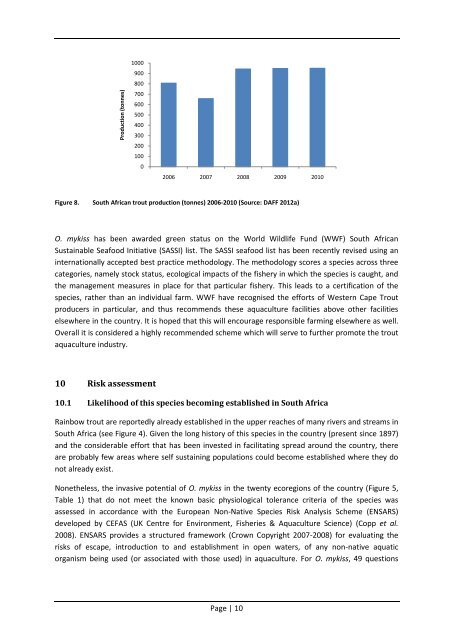Production (tonnes)100090080070060050040030020010002006 2007 2008 2009 2010Figure 8. South African trout production (tonnes) 2006-2010 (Source: DAFF 2012a)O. <strong>mykiss</strong> has been awarded green status on the World Wildlife Fund (WWF) South AfricanSustainable Seafood Initiative (SASSI) list. The SASSI seafood list has been recently revised using aninternationally accepted best practice methodology. The methodology scores a species across threecategories, namely stock status, ecological impacts <strong>of</strong> the fishery in which the species is caught, andthe management measures in place for that particular fishery. This leads to a certification <strong>of</strong> thespecies, rather than an individual farm. WWF have recognised the efforts <strong>of</strong> Western Cape <strong>Trout</strong>producers in particular, and thus recommends these aquaculture facilities above other facilitieselsewhere in the country. It is hoped that this will encourage responsible farming elsewhere as well.Overall it is considered a highly recommended scheme which will serve to further promote the troutaquaculture industry.10 Risk assessment10.1 Likelihood <strong>of</strong> this species becoming established in South Africa<strong>Rainbow</strong> trout are reportedly already established in the upper reaches <strong>of</strong> many rivers and streams inSouth Africa (see Figure 4). Given the long history <strong>of</strong> this species in the country (present since 1897)and the considerable effort that has been invested in facilitating spread around the country, thereare probably few areas where self sustaining populations could become established where they donot already exist.Nonetheless, the invasive potential <strong>of</strong> O. <strong>mykiss</strong> in the twenty ecoregions <strong>of</strong> the country (Figure 5,Table 1) that do not meet the known basic physiological tolerance criteria <strong>of</strong> the species wasassessed in accordance with the European Non-Native Species Risk Analysis Scheme (ENSARS)developed by CEFAS (UK Centre for Environment, Fisheries & Aquaculture Science) (Copp et al.2008). ENSARS provides a structured framework (Crown Copyright 2007-2008) for evaluating therisks <strong>of</strong> escape, introduction to and establishment in open waters, <strong>of</strong> any non-native aquaticorganism being used (or associated with those used) in aquaculture. For O. <strong>mykiss</strong>, 49 questionsPage | 10
were answered, providing a confidence level and justification (with source listed) for each answer.The results <strong>of</strong> the assessment on O. <strong>mykiss</strong> can be found in Appendix 1.The outcome <strong>of</strong> the scoring was for O. <strong>mykiss</strong> to be further evaluated before introductions in thetwenty remaining ecoregions. However, this was a conservative score for general O. <strong>mykiss</strong> farming,and accordingly, we have adapted this result with each different culture technique in mind (section12).10.2 Potential ecological impactsEscapees from aquaculture facilities are inevitable and occur worldwide unless mitigatory methodsare applied. <strong>Rainbow</strong> trout which escape from aquaculture farms have been found to travel up to360 km and have a 50% chance <strong>of</strong> survival, with some individuals surviving up to one year in the wild(Paterson 2010). Therefore, the impacts <strong>of</strong> an introduction could potentially spread across an entireriver catchment very rapidly. However, this study did not research the breeding potential <strong>of</strong> escapedfish so the impacts may be transient. In Scotland, escapees do not compete with native stocks, andtherefore do not contribute greatly to the breeding population (Duncan 1991).As there was no biological baseline survey done in South Africa in the 19 th century prior to the arrival<strong>of</strong> O. <strong>mykiss</strong>, it is very challenging (as with many species) to accurately predict the impact <strong>of</strong> rainbowtrout introductions (Bartley & Casal 1998).<strong>Rainbow</strong> trout are currently reported as a threat to at least 10 <strong>of</strong> the 50 South African fish species inthe Red Data Book, through predation or competition. It is unclear whether these populations <strong>of</strong> O.<strong>mykiss</strong> are the result <strong>of</strong> farm escapees or the intentional release by anglers. The species affectedprimarily belong to the genus Barbus or Pseudobarbus (minnows), however Sandelia bainsii andKneria auriculata are also affected (Skelton 1987). For example, Barbus treurensis is currently classedas endangered on the IUCN Red List (Engelbecht & Bills 2007). The upper Blyde River and the TreurRiver in the Limpopo River system are the only sites this species is found naturally (Kleynhans 1987).However, due to O. <strong>mykiss</strong>, these numbers are dwindling and subsequent re-introductions havebeen undertaken to increase stocking as well as designating the areas as National Heritage sites(Engelbrecht & Bills 2007). Following the stocking <strong>of</strong> the Crocodile River (Incomati River System) withrainbow trout, the indigenous Kneria auriculata was extirpated. However, when the alien speciesdisappeared, K. ariculata succeeded in re-colonising the river (Kleynhans 1988). The presence <strong>of</strong> O.<strong>mykiss</strong> has been implicated in the decline <strong>of</strong> amphibian species, Hadromophryne natalensis, inuKhahlamba Drakensberg Park World Heritage Site (Karssing 2010).The risk <strong>of</strong> O. <strong>mykiss</strong> hybridising with another indigenous species in South Africa is considered to bevery low. There is low risk <strong>of</strong> the rainbow trout hybridizing with other congenerics as there are nonative Salmonidae in South Africa.High stocking densities commonly found in hatcheries can lead to outbreaks <strong>of</strong> parasites anddiseases, if the hatchery design and management is not well maintained. Some <strong>of</strong> the parasiteswhich affect trout may also affect other freshwater finfish. If unknown diseases are introduced,indigenous species may not have an adequate immune system to cope with them, and as a result itcan lead to their demise. Risks associated with introduction <strong>of</strong> diseases and parasites to nativePage | 11
















